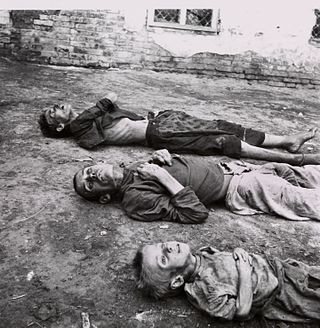
A famine is a widespread scarcity of food, caused by several factors including war, natural disasters, crop failure, widespread poverty, an economic catastrophe or government policies. This phenomenon is usually accompanied or followed by regional malnutrition, starvation, epidemic, and increased mortality. Every inhabited continent in the world has experienced a period of famine throughout history. During the 19th and 20th century, Southeast and South Asia, as well as Eastern and Central Europe, suffered the greatest number of fatalities. Deaths caused by famine declined sharply beginning in the 1970s, with numbers falling further since 2000. Since 2010, Africa has been the most affected continent in the world by famine.
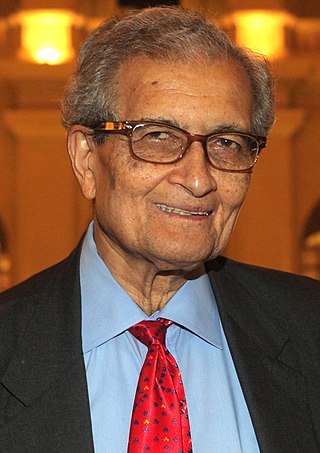
Amartya Kumar Sen is an Indian economist and philosopher, who since 1972 has taught and worked in the United Kingdom and the United States. Sen has made contributions to welfare economics, social choice theory, economic and social justice, economic theories of famines, decision theory, development economics, public health, and measures of well-being of countries.

The Population Bomb is a 1968 book co-authored by former Stanford University professor Paul R. Ehrlich and former Stanford senior researcher in conservation biology Anne H. Ehrlich. From the opening page, it predicted worldwide famines due to overpopulation, as well as other major societal upheavals, and advocated immediate action to limit population growth. Fears of a "population explosion" existed in the mid-20th century baby boom years, but the book and its authors brought the idea to an even wider audience.

In politics, humanitarian aid, and the social sciences, hunger is defined as a condition in which a person does not have the physical or financial capability to eat sufficient food to meet basic nutritional needs for a sustained period. In the field of hunger relief, the term hunger is used in a sense that goes beyond the common desire for food that all humans experience, also known as an appetite. The most extreme form of hunger, when malnutrition is widespread, and when people have started dying of starvation through lack of access to sufficient, nutritious food, leads to a declaration of famine.
Famine relief is an organized effort to reduce starvation in a region in which there is famine. A famine is a phenomenon in which a large proportion of the population of a region or country are so undernourished that death by starvation becomes increasingly common. In spite of the much greater technological and economic resources of the modern world, famine still strikes many parts of the world, mostly in the developing nations.
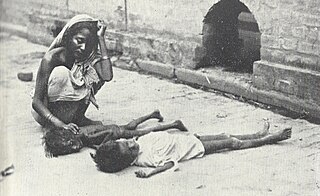
The Bengal famine of 1943 was an anthropogenic famine in the Bengal province of British India during World War II. An estimated 2.1–3 million people died, in the Bengal region, from starvation, malaria and other diseases aggravated by malnutrition, population displacement, unsanitary conditions and lack of health care. Millions were impoverished as the crisis overwhelmed large segments of the economy and catastrophically disrupted the social fabric. Eventually, families disintegrated; men sold their small farms and left home to look for work or to join the British Indian Army, and women and children became homeless migrants, often travelling to Calcutta or other large cities in search of organised relief.
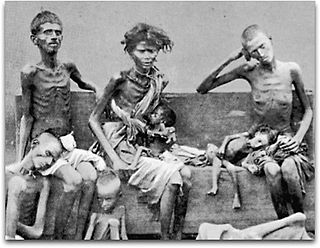
Famine had been a recurrent feature of life in the South Asian subcontinent countries of India and Bangladesh, most notoriously under British rule. Famines in India resulted in millions of deaths over the course of the 18th, 19th, and early 20th centuries. Famines in British India were severe enough to have a substantial impact on the long-term population growth of the country in the 19th and early 20th centuries.
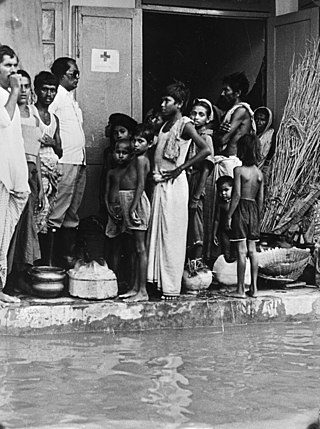
The Bangladesh famine of 1974 began in March 1974 and ended in about December of the same year. The famine is considered one of the worst in the 20th century; it was characterised by massive flooding along the Brahmaputra River as well as high mortality.
The North Korean famine, also known as the Arduous March or the March of Suffering, was a period of mass starvation together with a general economic crisis from 1994 to 1998 in North Korea. During this time there was an increase in defection from North Korea which peaked towards the end of the famine period.

The timeline of major famines in India during British rule covers major famines on the Indian subcontinent from 1765 to 1947. The famines included here occurred both in the princely states, British India and Indian territories independent of British rule such as the Maratha Empire.

The Indian famine of 1899–1900 began with the failure of the summer monsoons in 1899 over Western and Central India and, during the next year, affected an area of 476,000 square miles (1,230,000 km2) and a population of 59.5 million. The famine was acute in the Central Provinces and Berar, the Bombay Presidency, the minor province of Ajmer-Merwara, and the Hissar District of the Punjab; it also caused great distress in the princely states of the Rajputana Agency, the Central India Agency, Hyderabad and the Kathiawar Agency. In addition, small areas of the Bengal Presidency, the Madras Presidency and the North-Western Provinces were acutely afflicted by the famine.
Benny Dembitzer is a British economist who has specialized in international economic development issues and consequences of climate change, in particular in the economies of sub-Saharan Africa. He is Visiting Professor of Global Economics at the China Centre of University College, London and a Rockefeller Fellow. He has worked for a variety of NGOs and United Nations agencies. His work has taken him to 35 different countries in sub-Saharan Africa, as well as Indonesia, Pakistan, Chile and Brazil. He was director of the European Office of International Physicians for the Prevention of Nuclear War, when the organization was awarded the 1985 Nobel Peace Prize.
Susanne Hoeber Rudolph was an American author, political thinker and educationist. She was a William Benton Distinguished Service Professor Emerita at the University of Chicago and was actively interested in Politics, Political Economy and Political Sociology of South Asia, State Formation, Max Weber and the Politics of Category and Culture. The Government of India, in 2014, honored her, along with her husband, Lloyd I. Rudolph, for their services to literature and education, by bestowing on them the third highest civilian award, the Padma Bhushan.

Nuclear famine is a hypothesized famine considered a potential threat following global or regional nuclear exchange. It is thought that even subtle cooling effects resulting from a regional nuclear exchange could have a substantial impact on agriculture production, triggering a food crisis amongst the world's survivors.

Mexico has sought to ensure food security through its history. Yet, despite various efforts, Mexico continues to lack national food and nutrition strategies that secure food security for the people. As a large country of more than 100 million people, planning and executing social policies are complex tasks. Although Mexico has been expanding its food and nutrition programs that have been expected, and to some degree, have contributed to increases in health and nutrition, food security, particularly as it relates to obesity and malnutrition, still remains a relevant public health problem. Although food availability is not the issue, severe deficiencies in the accessibility of food contribute to insecurity.

The Bengal famine of 1943-44 was a major famine in the Bengal province in British India during World War II. An estimated 2.1 million, out of a population of 60.3 million, died from starvation, malaria and other diseases aggravated by malnutrition, population displacement, unsanitary conditions, and lack of health care. Millions were impoverished as the crisis overwhelmed large segments of the economy and social fabric.
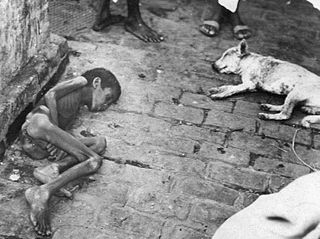
The Famine Inquiry Commission, also known as the Woodhead Commission, was appointed by the Government of British India in 1944 to investigate the 1943 Bengal famine. Controversially, it declined to blame the British government and emphasised the natural, rather than man-made, causes of the famine.
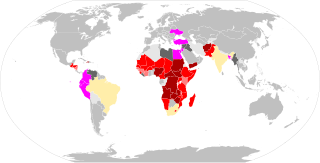
During the COVID-19 pandemic, food insecurity has intensified in many places – in the second quarter of 2020 there were multiple warnings of famine later in the year. In an early report, the Nongovernmental Organization (NGO) Oxfam-International talks about "economic devastation" while the lead-author of the UNU-WIDER report compared COVID-19 to a "poverty tsunami". Others talk about "complete destitution", "unprecedented crisis", "natural disaster", "threat of catastrophic global famine". The decision of WHO on March 11, 2020 to qualify COVID as a pandemic, that is "an epidemic occurring worldwide, or over a very wide area, crossing international boundaries and usually affecting a large number of people" also contributed to building this global-scale disaster narrative.
The Bihar drought of 1966–1967 was a drought in Bihar and eastern Uttar Pradesh. The official death toll from starvation in the Bihar drought was 2353, roughly half of which occurred in the state of Bihar.

The premiership of Sheikh Mujibur Rahman began on January 12 of 1972 when he was sworn in as the Prime Minister of Bangladesh after briefly serving as the President after returning from Pakistan's jail on January 10, 1972. He served as the Prime Minister of Bangladesh until January 25, 1975, for three years, and later led the parliament to adopt an amendment of the constitution that made him the President of Bangladesh, effectively for life.














